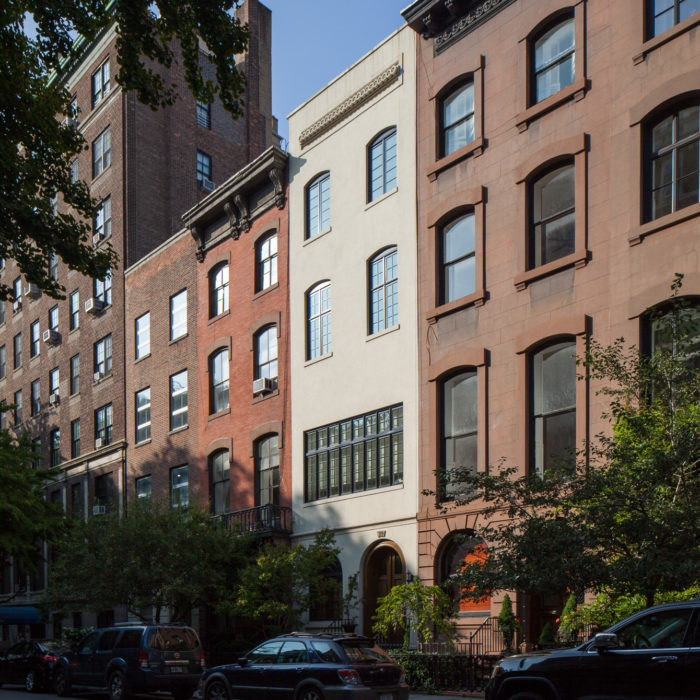
Maurice Sendak Residence & Studio
overview
The award-winning children’s book author and illustrator Maurice Sendak lived and worked in a duplex apartment in this Greenwich Village rowhouse from 1962 to 1972, with his life partner, psychoanalyst Eugene Glynn.
During these years, Sendak worked on beloved books, such as Where the Wild Things Are (1963), which brought him international acclaim, and In the Night Kitchen (1970), from his art studio here.
History
Maurice Sendak (1928-2012), regarded as the 20th century’s most important children’s book illustrator, was born in Brooklyn to Polish-Jewish immigrants. His ill health as a child and the loss of relatives to the Holocaust impacted his work, with his obituary in the New York Times noting that he “wrenched the picture book out of the safe, sanitized world of the nursery and plunged it into the dark, terrifying and hauntingly beautiful recesses of the human psyche.” His big break came in the early 1950s, when renowned children’s book editor Ursula Nordstrom, of Harper & Row, hired him to illustrate children’s books after seeing the window displays he created for F.A.O. Schwarz. Nordstrom went on to be his most significant collaborator.
By the mid-1950s, Sendak began writing and illustrating his own books. While living in a duplex apartment (basement and ground floor) at 29 West 9th Street in Greenwich Village, where he moved in 1962, he completed the text and illustrations for his best-selling picture book, Where the Wild Things Are (1963). His family in Brooklyn inspired the story for the book, which earned Sendak the prestigious Caldecott Medal in 1964.
A selection of other books that Sendak worked on from his 9th Street art studio include The Animal Family (1965; illustrations only), Higglety Pigglety Pop! (1967), and In the Night Kitchen (1970). He also served as an early member of the National Board of Advisors for the Children’s Television Workshop, which was then developing Sesame Street (1969-present); Sendak’s Bumble Ardy (1970) and three other animated stories appeared on the show. In 1970, he became the first American to win the Hans Christian Andersen Medal for illustrators.
Sendak admits that [his illustrations of children] are a curious admixture of Brooklyn remembered and shtetl … life in Poland fantasized, ‘never actually experienced but passed on to me as persuasive reality by my immigrant parents.’
His 9th Street art studio, connected to the kitchen-dining room by a long, narrow corridor, was described as “small, dark, nestlike and thronged with books, records, drawings and artifacts” in a 1970 New York Times article. The only light in the room hung above his drawing board. The article calls Sendak a “42-year-old bachelor” and mentions his “friend,” psychoanalyst Eugene Glynn, who was actually his life partner (the couple lived together for 50 years, until Glynn’s death in 2007). Towards the end of his life, Sendak acknowledged that he had kept his homosexuality hidden from his parents and the public, knowing that bias toward him being a gay man working in children’s literature would have negatively affected his budding career.
In 1972, Sendak (with Glynn) moved to Ridgefield, Connecticut, where he lived until his death. President Bill Clinton presented him with the National Medal of Arts in 1996. The Maurice Sendak Collection, which includes original artwork, books, and other items, was donated to the University of Connecticut in 2018.
Entry by Amanda Davis, project manager (January 2020).
NOTE: Names above in bold indicate LGBT people.
Building Information
- Architect or Builder: Dennis McDermott (builder); James Renwick, Jr. (possible architect)
- Year Built: 1854 (since altered)
Sources
Greenwich Village Historic District Designation Report (New York: Landmarks Preservation Commission, 1969).
John Wilcock, “The Wonderful World of Maurice Sendak,” The Village Voice, September 26, 1956, 3-4.
Lisa Hammel, “Maurice Sendak: Thriving on Quiet,” The New York Times, January 5, 1973, 36.
Margalit Fox, “A Conjurer of Luminous Worlds, Both Beautiful and Terrifying,” The New York Times, May 9, 2012, A1, B20. [source of obituary quote]
“Maurice Sendak,” Muppet Wiki, bit.ly/304la4C.
New York Telephone White Pages, 1961-1962; 1962-1963, The New York Public Library.
Patricia Cohen, “Concerns Beyond Just Where the Wild Things Are,” The New York Times, September 10, 2008, E1.
Saul Braun, “Sendak Raises The Shade On Childhood,” The New York Times, June 7, 1970, 34, 37, 40, 49, 52. [source of pull quote and all 1970 NYT quotes]
Do you have more information about this site?
This project is enriched by your participation! Do you have your own images of this site? Or a story to share? Would you like to suggest a different historic site?





